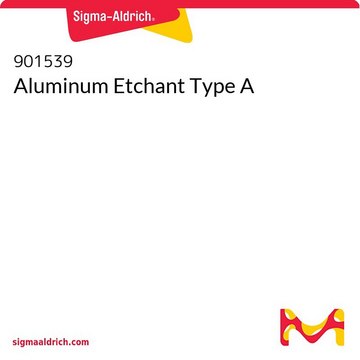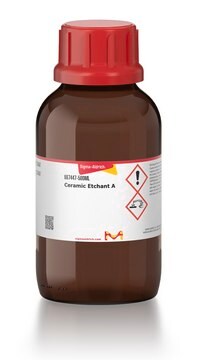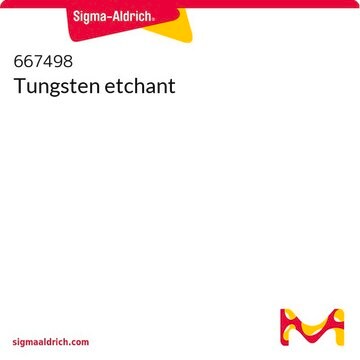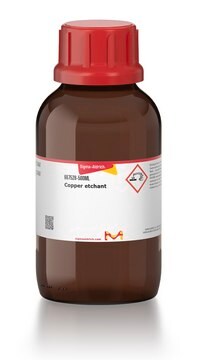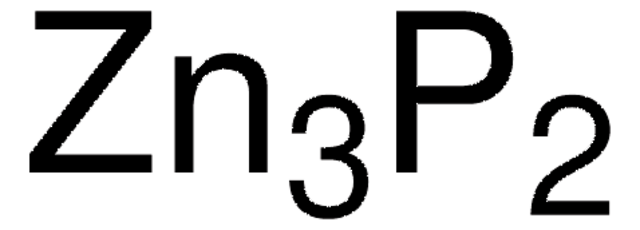901545
Aluminum Etchant Type D
Sinónimos:
Aluminum etching solution for use on gallium arsenide and gallium phosphide devices
Iniciar sesiónpara Ver la Fijación de precios por contrato y de la organización
About This Item
UNSPSC Code:
12352311
NACRES:
NA.23
Productos recomendados
form
liquid
General description
ALUMINUM ETCHANT - TYPE D
- Standard aluminum etchant for use on gallium arsenide, arsenide and gallium phosphide devices and for aluminum metallizations on nichrome resistors
- Aluminum etchants are stable, non-toxic preparations used to etch aluminum metallizations on silicon devices and in integrated circuit applications. Aluminum contacts are defined, and interconnections are formed. These Aluminum Etchants, formulated with unique properties, easily overcome many of the difficulties experienced in aluminum etch processes.
- The aluminum metallization and etching process using photo-lithographic techniques is basic to semiconductor and microelectronic technology. Aluminum etchants are highly compatible with commercial photoresists and permit delineation into high resolution patterns. Metal line width of 1 mil and separations less than 5 microns are feasible. High resolution is practical with these aluminum etchants because lifting of photoresist patterns does not occur and undercutting is minimized. Furthermore, the etchants do not attack silicon, silicon dioxide, silicon nitride or nichrome resistor films.
- Two aluminum etchants are offered for use in microelectronics. Type A is recommended for use on silicon devices. Type D is recommended for use on gallium arsenide and gallium phosphide devices to avoid attack of the etchant on the intermetallic compound. It is also recommended for etching aluminum metallizations on nichrome thin film resistors.
Application
- Aluminum metallizations up to 25,000 Å are vacuum deposited on the silicon slice, coated with a photoresist, and UV exposed using an appropriate photographic mask. The resist is developed to protect the aluminum where interconnections are desired. Then the unprotected areas of the aluminum are removed by etching with the aluminum etchant, followed by a water rinse.
- Etching time is dependent upon the etchant temperature and the aluminum film thickness. When etching thick aluminum films, a higher etch rate is required; thus a higher etchant temperature should be used. Likewise, for thinner aluminum films, slower etch rates are desired and a lower etchant temperature should be chosen.
- At a specific etchant temperature, the etching time is given by the following formula:
where Etch Rate at 25°C 30 Å/sec; at 40°C 80 Å/sec.
Features and Benefits
- Controlled etch rates
- Selective etching: will not attack SiO2 or Si3N4
- Offers high resolution with minimal undercutting
- Eliminates smut formation
- Economical; reusable
signalword
Danger
hcodes
Hazard Classifications
Acute Tox. 4 Oral - Eye Dam. 1 - Flam. Liq. 3 - Met. Corr. 1 - Skin Corr. 1B - Skin Sens. 1
Storage Class
3 - Flammable liquids
wgk_germany
WGK 1
Certificados de análisis (COA)
Busque Certificados de análisis (COA) introduciendo el número de lote del producto. Los números de lote se encuentran en la etiqueta del producto después de las palabras «Lot» o «Batch»
¿Ya tiene este producto?
Encuentre la documentación para los productos que ha comprado recientemente en la Biblioteca de documentos.
Nuestro equipo de científicos tiene experiencia en todas las áreas de investigación: Ciencias de la vida, Ciencia de los materiales, Síntesis química, Cromatografía, Analítica y muchas otras.
Póngase en contacto con el Servicio técnico